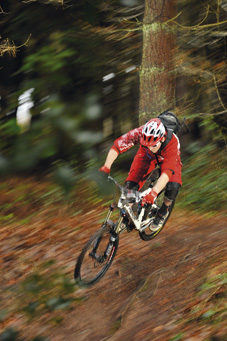 SUSPENSION
SUSPENSION
Like the Combi S, Merida’s design necessitates an asymmetrical lower pivot yoke. The difference is that, due to the pivot being behind the bottom bracket, the swingarm is shorter and the flex is barely noticeable. Sadly the long rocker plate adds another element of flexibility to the design and despite its immaculate matt black finish, does nothing to improve the tracking of the rear triangle. A Suntour XC Pro shock offers adjustable rebound damping and twin mounting points allow for 115 or 130mm of travel. Our test machine came with 100mm-travel RockShox Dart forks, which not only offered mismatched travel but lowered the bottom bracket and steepened the front end.
WHEELS
To match the all-mountain name tag, Merida specs 2.35in tyres on the AM 500-D. These not only improve traction but also increase the comfort aspect of the ride, thanks to a large air volume. They also, thanks to a short knobbed design, roll quite well, and the well-supported treads offer excellent traction in a range of conditions.
COMPONENTS
FSA’s chainset did little to spoil the excellent drivetrain and the full Deore shifting set guaranteed smooth, light action gears.
It’s fair to say that Tektro’s twin-piston hydraulic brakes may not have the most comfortable levers, but they never once failed to haul the rig to a stop, no matter how muck covered.
Own-brand finishing kit is common on these bikes. A comfortable enough saddle and full width riser bars are great, but the 100mm stem is just too long. Far too much rider weight is dragged over the front wheel and steep trails are more nerve-wracking than necessary.
PERFORMANCE
A 100mm stem has no place on a mountain bike designed for riding on technical trails, and the X Mission fitted here slowed down the steering response and stretched the rider too much. Longer travel at the rear should have improved downhill performance, but a steeper seat angle meant the rider’s weight was further forward, compounding the issues with the short fork.
Our biggest issue, though, was with the low bottom bracket. At only 12in, we regularly caught our pedal or foot on trail obstacles, even when climbing.
The fact that the suspension seemed too willing to blow through the first half of its travel adds to the issues. The bike sits into its travel too readily even when set up with the correct amount of sag.
VERDICT
Despite an air-sprung rear end, the Merida is as heavy as the coil-sprung Claud Butler. Sadly it didn’t offer the same degree of stiffness. Long rocker plates no doubt contributed to both issues. With geometry perfect for getting the miles in, the AM 500-D should suit riders looking for a bike for moorland hacks, rather than messing about in the woods. Even with a longer fork, the Merida will never feel as nimble as the Commençal, and it’s a world away from the playful Claud Butler, but if you’re getting into the sport in order to check the view rather than the drop-offs then it is an option.
MBR RATING: 7/10



